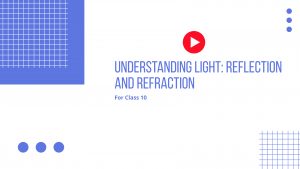NCERT Solutions for Maths Class 10 Chapter 9
Exercise 9.1
Question 1: A circus artist is climbing a \(20\space m\) long rope, which is tightly stretched and tied from the top of a vertical pole to the ground. Find the height of the pole, if the angle made by the rope with the ground level is\(30^0\).

Answer: It can be observe from the figure that \(AB\) is the pole.
In \(\Delta ABC\),
\(\frac{AB}{AC}=sin\space 30^0\)
\(\frac{AB}{20}=\frac{1}{2}\)
\(AB=\frac{20}{2}=10\)
Therefore, the height of the pole is \(10\space m\).
Question 2: A tree breaks due to storm and the broken part bends so that the top of the tree touches the ground making an angle \(30^0\) with it. The distance between the foot of the tree to the point where the top touches the ground is 8 m. Find the height of the tree.
Answer:

Let \(AC\) was the original tree. Due to storm, it was broken into two parts. The broken Part \(\Delta A’BC\) is making \(30^0\) with the ground.
\(\frac{BC}{A’C}=tan\space 30^0\)
\(\frac{BC}{8}=\frac{1}{\sqrt3}\)
\(BC=(\frac{8}{\sqrt3})m\)
\(\frac{A’C}{A’B}=\frac{\sqrt3}{2}\)
\(A’B=(\frac{16}{\sqrt3})m\)
Height of tree \(=A’B+BC\)
\(=(\frac{16}{\sqrt3}+\frac{8}{\sqrt3})m=\frac{24}{\sqrt3}m\)
\(=8\sqrt3\space m\)
Hence, the height of the trees is \(8\sqrt3\space m\)
Question 3:


It can be observed that \(AC\) and \(PR\) are the slides for younger and elder children respectively.
In \(\Delta ABC\),
\(\frac{AB}{AC}=sin\space 30^0\)
\(\frac{1.5}{AC}=\frac{1}{2}\)
\(AC=3\space m\)
In \(\Delta PQR\)
\(\frac{PQ}{PR}=sin\space 60^0\)
\(\frac{3}{PR}=\frac{\sqrt3}{2}\)
\(PR=\frac{6}{\sqrt3}=2\sqrt3\space m.\)
Therefore, the lenghths of these slides are \(3\space m\) and \(2\sqrt3\space m\).
Question 4: The angle of elevation of the top of a tower from a point on the ground, which is \(30\space m\) away from the foot of the tower is \(30^0\). Find the height of the tower.
Answer:

Let \(AB\) be the tower and the angle of elevation from point \(C\) (on ground) is \(30^0\).
In \(\Delta ABC\),
\(\frac{AB}{BC}=tan\space 30^0\)
\(\frac{AB}{30}=\frac{1}{\sqrt3}\)
\(AB=\frac{30}{\sqrt3}=10\sqrt3\space m\)
Therefore, the height of the tower is \(10\sqrt3\space m\)
Question 5: A kite is flying at a height of \(60\space m\) above the ground. The string attached to the kite is temporarily tied to a point on the ground. The inclination of the string with the ground is \(60^0\). Find the length of the string, assuming that there is no slack in the string.
Answer:

Let \(K\) be the kite and the string is tied to point \(P\) on the ground.
In \(ΔKLP\),
\(\frac{KL}{KP}=sin\space 60^0\)
\(\frac{60}{KP}=\frac{\sqrt3}{2}\)
\(KP=\frac{120}{\sqrt3}=40\sqrt3\space m\)
Hence, the length of the string is \(40\sqrt3\space m\).
Question 6: A \(1.5\space m\) tall boy is standing at some distance from a \(30\space m\) tall building. The angle of elevation from his eyes to the top of the building increases from \(30^0\) to \(60^0\) as he walks towards the building. Find the distance he walked towards the building.
Answer:

Let the boy was standing at point \(S\) initially. He walked towards the building and reached at point \(T\).
It can be observed that
\(PR=PQ-RQ\)
\(=(30-1.5)\space m=28.5\space m=\frac{57}{2}\space m\)
In \(\Delta PAR\),
\(\frac{PR}{AR}=tan\space 30^0\)
\(\frac{57}{2AR}=\frac{1}{\sqrt3}\)
\(AR=(\frac{57}{2}\sqrt3)\space m\)
In \(\Delta PRB\),
\(\frac{PR}{BR}=tan\space 60^0\)
\(\frac{57}{2BR}=\sqrt3\)
\(BR=\frac{57}{2\sqrt3}=(\frac{19\sqrt3}{2})\space m\)
\(ST=AB\)
\(=AR-BR(\frac{57\sqrt3}{2}-\frac{19\sqrt3}{2})\space m\)
\(=(\frac{38\sqrt3}{2})\space m=19\sqrt3\space m\)
Hence, he walked \(19\sqrt3\) towards the building.
Question 7: From a point on the ground, the angles of elevation of the bottom and the top of a transmission tower fixed at the top of a \(20\space m\) high building are \(45^0\) and \(60^0\) respectively. Find the height of the tower.
Answer:

Let \(BC\) be the building, \(AB\) be the transmission tower, and \(D\) be the point on the ground from where the elevation angles are to be measured.
In \(ΔBCD\),
\(\frac{BC}{CD}=tan\space 45^0\)
\(\frac{20}{CD}=1\)
\(CD=20\space m\)
In \(\Delta ACD\),
\(\frac{AC}{CD}=tan\space 60^0\)
\(\frac{AB+BC}{CD}=\sqrt3\)
\(\frac{AB+20}{2}=\sqrt3\)
\(AB=(20\sqrt3-20)\space m\)
\(=20(\sqrt3-1)\space m\)
Therefoer, the height of the transmission tower is \(20(\sqrt3-1)\)\space m\)
Question 8: A statue, \(1.6\space m\) tall, stands on a top of pedestal, from a point on the ground, the angle of elevation of the top of statue is \(60^0\) and from the same point the angle of elevation of the top of the pedestal is \(45^0\). Find the height of the pedestal.
Answer:

Let \(AB\) be the statue, \(BC\) be the pedestal, and \(D\) be the point on the ground from where the elevation angles are to be measured.
In \(\Delta BCD\),
\(\frac{BC}{CD}=tan\space 45^0\)
\(\frac{BC}{CD}=1\)
\(BC=CD\)
In \(\Delta ACD\),
\(\frac{AB+BC}{CD}=tan\space 60^0\)
\(\frac{AB}{BC}{BC}=\sqrt3\)
\(1.6+BC=Bc\sqrt3\)
\(BC(\sqrt3-1)=1.6\)
\(BC=\frac{(1.6)(\sqrt3+1)}{(\sqrt3-1)(\sqrt3+1)}\)
\(=\frac{1.6(\sqrt3+1)}{(\sqrt3)^2-(1)^2}\)
\(=\frac{1.6(\sqrt3+1)}{2}=0.8(\sqrt3+1)\)
Therefore, the height of the pedestal is \(0.8(\sqrt3+1)\space m\)
Question 9: The angle of elevation of the top of a building from the foot of the tower is \(30^0\) and the angle of elevation of the top of the tower from the foot of the building is \(60^0\). If the tower is \(50\space m\) high, find the height of the building.
Answer:

Let \(AB\) be the building and \(CD\) be the tower.
In \(\Delta CDB\),
\(\frac{CD}{BD}=tan\space 60^0\)
\(\frac{50}{BD}=\sqrt3\)
\(\frac{50}{BD}=\sqrt3\)
\(BD=\frac{50}{\sqrt3}\)
In \(\Delta ABD\),
\(\frac{AB}{BD}=tan\space 30^0\)
\(AB=\frac{50}{\sqrt3}\times\frac{1}{\sqrt3}=\frac{50}{3}=16\frac{2}{3}\)
Therefore, the height of the building is \(16=\frac{2}{3}\space m\).
Question 10: Two poles of equal heights are standing opposite each other an either side of the road, which is \(80\space m\) wide. From a point between them on the road, the angles of elevation of the top of the poles are \(60^0\) and \(30^0\), respectively. Find the height of poles and the distance of the point from the poles.
Answer:

Let \(AB\) and \(CD\) be the poles and \(O\) is the point from where the elevation angles are measured.
In \(\Delta ABO\),
\(\frac{AB}{BO}=tan\space 60^0\)
\(\frac{AB}{BO}=\sqrt3\)
\(BO=\frac{AB}{\sqrt3}\)
In \(\Delta CDO\),
\(\frac{CD}{DO}=tan\space 30^0\)
\(\frac{CD}{80-BO}=\frac{1}{\sqrt3}\)
\(CD\sqrt3=80-\frac{AB}{\sqrt3}\)
\(CD\sqrt3=\frac{AB}{\sqrt3}=80\)
Since the poles are of equal heights.
\(CD=AB\)
\(CD[\sqrt3+\frac{1}{\sqrt3}]=80\)
\(CD(\frac{3+1}{\sqrt3})=80\)
\(CD=20\sqrt3\space m\)
\(BO=\frac{AB}{\sqrt3}=\frac{CD}{\sqrt3}=(\frac{20\sqrt3}{\sqrt3})\space m=20\space m\)
\(DO=BD-BO=(80-20)\space m=60\space m\)
Therefore, the height of poles is \(20\sqrt3\space m\) and the point is \(20\space m\) far from these poles.
Quesiton 11: A TV tower stands vertically on a bank of a canal. From a point on the other bank directly opposite the tower the angle of elevation of the top of the tower is \(60^0\). From another point 20 m away from this point on the line joining this point to the foot of the tower, the angle of elevation of the top of the tower is \(30^0\). Find the height of the tower and the width of the canal.

Answer:
In \(\Delta ABC\),
\(\frac{AB}{BC}=tan\space 60^0\)
\(\frac{AB}{BC}=\sqrt3\)
\(BC=\frac{AB}{\sqrt3}\)
In \(\Delta ABD\),
\(\frac{AB}{BD}=tan\space 30^0\)
\(\frac{AB}{BC+CD}=\frac{1}{\sqrt3}\)
\(\frac{AB}{\frac{AB}{\sqrt3}+20}=\frac{1}{\sqrt3}\)
\(\frac{AB\sqrt3}{AB+20\sqrt3}=\frac{1}{\sqrt3}\)
\(3AB=AB+20\sqrt3\)
\(2AB=20\sqrt3\)
\(AB=10\sqrt3\space m\)
\(BC=\frac{AB}{\sqrt3}=(\frac{10\sqrt3}{\sqrt3})\space m=10\space m\)
Therefore, the height of the tower is \(10\sqrt3\space m\) and the width of the canal is \(10\space m\).
Question 12: From the top of a \(7\space m\) high building, the angle of elevation of the top of a cable tower is \(60^0\) and the angle of depression of its foot is \(45^0\) Determine the height of the tower.
Answer: 
Let \(AB\) be a building and \(CD\) be a cable tower. In \(\Delta ABD\),
\(\frac{AB}{BD}=tan\space 45^0\)
\(\frac{7}{BD}=1\)
\(BD=7\space m\)
In \(\Delta ACE\),
\(AC=BC=7\space m\)
\(\frac{CE}{AE}=tan\space 60^0\)
\(\frac{CE}{7}=\sqrt3\)
\(CE=7\sqrt3\space m\)
\(CD=CE+ED=(7\sqrt3+7)\space m\)
\(=7(\sqrt3+1)\space m\)
Therefore, the height of the cable tower is \(7(\sqrt3+1)\space m\).
Question 13: As observed from the top of a \(75\space m\) high lighthouse from the sea-level, the angles of depression of two ships are \(30^0\) and \(45^0\). If one ship is exactly behind the other on the same side of the lighthouse, find the distance between the two ships.
Answer:

Let \(AB\) be the lighthouse and the two ships be at point \(C\) and \(D\) respectively.
In \(ΔABC\),
\(\frac{AB}{BC}=tan\space 45^0\)
\(\frac{75}{BC}=1\)
\(=BC=75\space m\)
In \(\Delta ABD\),
\(\frac{AB}{BC}=tan\space 30^0\)
\(\frac{75}{BC+CD}=\frac{1}{\sqrt3}\)
\(\frac{75}{BC+CD}=\frac{1}{\sqrt3}\)
\(\frac{75}{75+CD}=\frac{1}{\sqrt3}\)
\(75\sqrt3=75+CD\)
\(75(\sqrt3-1)\space m=CD\)
Therefore, the distance between the two ships is \(75(\sqrt3-1)\space m\).
Question 14: A \(1.2\space m\) tall girl spots a balloon moving with the wind in a horizontal line at a height of \(88.2\space m\) from the ground. The angle of elevation of the balloon from the eyes of the girl at any instant is \(60^0\). After some time, the angle of elevation reduces to \(30^0\). Find the distance travelled by the balloon during the interval.

Ansswer:

Let the initial position \(A\) of ballon change \(B\) after some time and \(CD\) be the girl.
In \(\Delta ACE\),
\(\frac{AE}{CE}=tan\space 60^0\)
\(\frac{AF-EF}{CE}=tan\space 60^0\)
\(\frac{88.2-1.2}{CE}=\sqrt3\)
\(\frac{87}{CE}=\sqrt3\)
\(CE=\frac{87}{\sqrt3}=29\sqrt3\space m\)
In \(\Delta BCG\),
\(\frac{BG}{CG}=tan\space 30^0\)
\(\frac{88.2-1.2}{CG}=\frac{1}{\sqrt3}\)
\(87\sqrt3\space m=CG\)
Distance travelled by ballon \(=EG=CG-CE\)
\(=(87\sqrt3-29\sqrt3)\space m\)
\(=58\sqrt\space m\)
Question 15: A straight highway leads to the foot of a tower. A man standing at the top of the tower observes a car as an angle of depression of \(30^0\). which is approaching the foot of the tower with a uniform speed. Six seconds later, the angle of depression of the car is found to be \(60^0\). Find the time taken by the car to reach the foot of the tower from this point.
Answer:

Let \(AB\) be the tower.
Initial position of the car is \(C\), which changes to \(D\) after six seconds.
In \(ΔADB\),
\(\frac{AB}{DB}=tan\space 60^0\)
\(\frac{AB}{DB}=\sqrt3\)
\(=DB=\frac{AB}{\sqrt3}\)
In \(\Delta ABC\),
\(\frac{AB}{BC}=tan\space 30^0\)
\(\frac{AB}{BD+DC}=\frac{1}{\sqrt3}\)
\(AB\sqrt3=BD+DC\)
\(AB\sqrt3=\frac{AB}{\sqrt3}+DC\)
\(DC=AB\sqrt3-\frac{AB}{\sqrt3}=AB(\sqrt3-\frac{1}{\sqrt3})\)
\(AB\sqrt3=BD+DC\)
\(AB\sqrt3=\frac{AB}{\sqrt3}+DC\)
\(DC=Ab\sqrt3-\frac{AB}{\sqrt3}=AB(\sqrt3-\frac{1}{\sqrt3})\)
\(=\frac{2\space AB}{\sqrt3}\)
Time taken by the car to travel distance \(DC\) (i.e., \(\frac{2\space AB}{\sqrt3}\)) \(6\) seconds.
Time takne by the car to travel distance \(DB\) (i.e, \(\frac{AB}{\sqrt3}\))
\(=\frac{6}{\frac{2\space AB}{\sqrt3}}\times\frac{AB}{\sqrt3}=\frac{6}{2}=3\) seconds.
Question 16: The angles of elevation of the top of a tower from two points at a distance of \(4\space m\) and \(9\space m\). from the base of the tower and in the same straight line with it are complementary. Prove that the height of the tower is \(6\space m\).
Answer:

Let \(AQ\) be the tower and \(R,\space S\) are the points \(4\space m,\space 9\space m\) away from the base of the tower respectively
The angles are complementary.
Therefore, if one angle is \(θ\), the other will be \(90 − θ\).
In \(ΔAQR\),
\(\frac{AQ}{QR}=tan\space \theta\)
\(\frac{AQ}{4}=tan\space\theta\) …(i)
In \(\Delta AQS\),
On multiplying equations (i) and (ii), we obtain
\(\frac{AQ}{SQ}=tan\space (90-\theta)\)
\(\frac{AQ}{9}=cot\space \theta\) ..(ii)
\((\frac{AQ}{4})(\frac{AQ}{9})=(tan\space\theta).(cot\space\theta)\)
\(\frac{AQ^2}{36}=1\)
\(AQ^2=36\)
\(AQ=\sqrt{36}=\ne6\)
However, height cannot be negative.
Therefore, the height of the tower is \(6\space m\).
Study materials
- Refernce Books
- NCERT Solutions
- Syllabus







